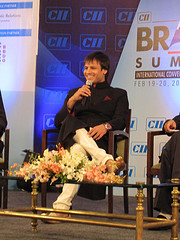
On answer that has risen to some level of prominence in India is the use of celebrities in marketing. You could argue that celebrities are popular everywhere in the world, but in a country that release more films in an average week than most countries do in an entire year, the rules are slightly different. In India it is not uncommon to see a Bollywood star's face on everything from facial tissues to pens. Celebrity is used to connote trust, and in a culture with many different socio-economic classes (they even have names), the only way that marketers can often reach across these levels is with celebrities that many people recognize.
In an illuminating panel filled with journalists, filmmakers, marketers, creative directors and one celebrity (Bollywood Actor Vivek Oberoi) the conversation turned to a in-depth discussion of the role of celebrity in marketing in India and whether it was indeed a necessity, or whether it has become a "crutch" for the lazy marketer who doesn't want to do any real work so they just hire a celebrity and consider their marketing efforts complete. Here were some of the biggest takeaways that the conversation raised for me:
- Understand the difference between talent and celebrity. When you hire an actor to play a part in an ad, you are hiring them as "talent." When you get a celebrity, you are hiring them to bring their personal brand to your product or service and serve as a spokesperson of sorts. The first key is to know the difference and not confuse the two.
- Start with an idea, not a celebrity. Often a marketing strategy starts by selecting the celebrity the team will work with and then an idea is built around that choice. This method is backwards and results in marketing that lacks strategic vision and often fails to resonate. To do better, you need to have a strong creative idea … then find the celebrity that best fits that idea.
- Build on a celebrities' personal brand. Vivek Oberoi raised many intelligent points about the celebrity point of view when it comes to marketing (something we don't often hear). He understands his personal brand and what resonates positively or negatively with it. As a result, he chooses personally not to do tobacco or alcohol related advertising. Many other celebrities lack those same principles and simply go where the biggest dollars tempt them. The best marketing will be something builds on the personal brand that a celebrity has built, instead of ignoring or countering it.
- Use real people too. Thankfully, the point did emerge from the panel that there may be times where you don't NEED a celebrity. There is a power of real people to connect with one another that can be missing with celebrity focused campaigns and for a growing number of brands in India taking this real approach is working well and shouldn't be discounted.
Note: This post was originally published on the Ogilvy 360 Digital Influence blog.






WE RECENTLY REMOVED COMMENTING - LEARN WHY HERE >